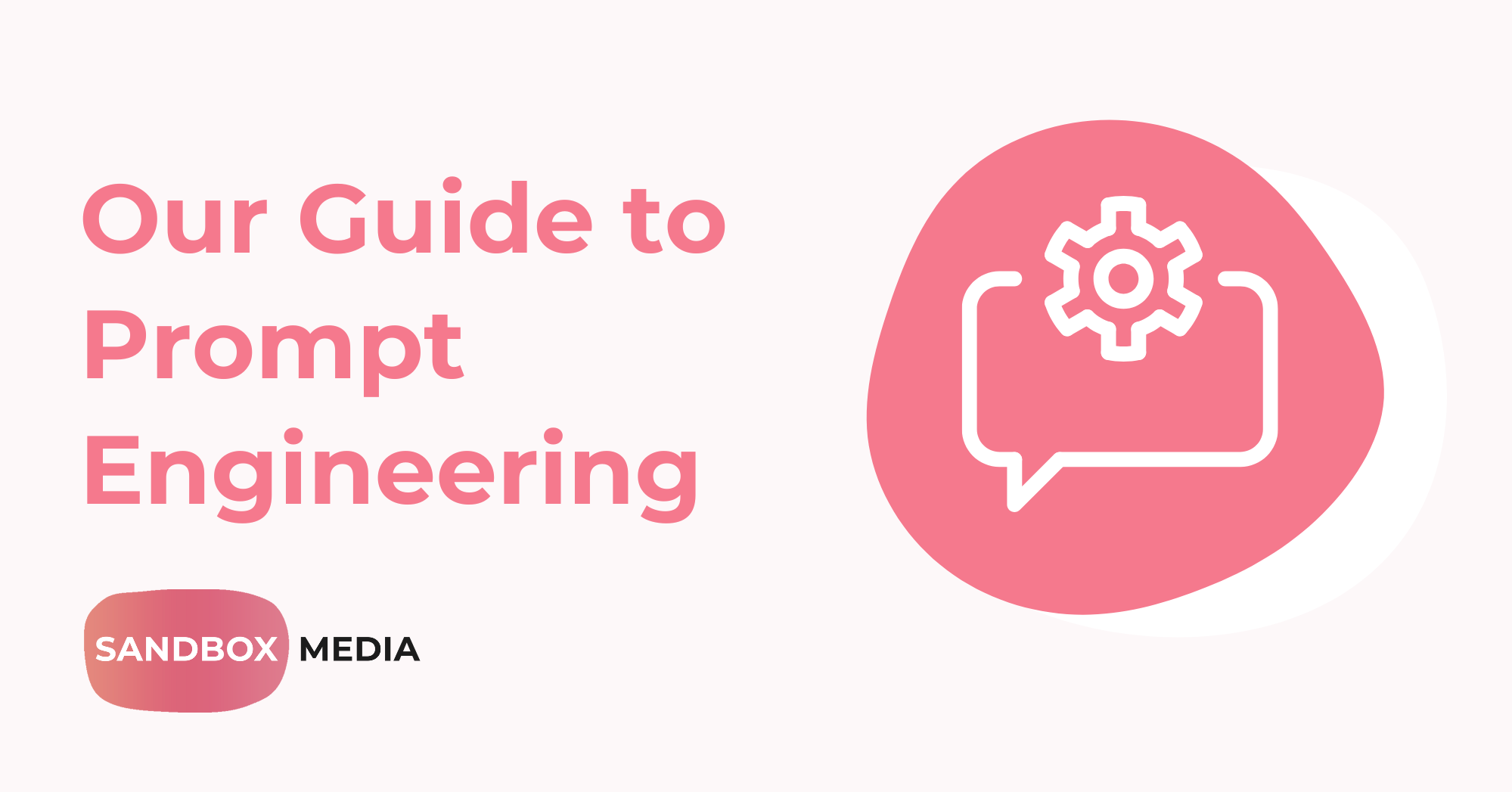Prompt engineering is an evolving skill that shapes how we interact with generative artificial intelligence (AI) tools.
In this space, the old saying rings true: “What you put in, you get out.” If you submit a vague prompt, that often leads to a weak or generic response.
A well-crafted, detailed prompt can return content that’s insightful, structured, and genuinely valuable.
Table of Contents
What is Prompt Engineering?
Prompt engineering is the practice of creating input instructions, or “prompts,” to direct the outputs of AI models.
As AI becomes increasingly integrated into content creation, data analysis, coding, and customer service, understanding how to work effectively with these systems can make a significant difference in quality and reliability.
Prompt engineering is fundamentally about interacting with AI in a way that yields precise, useful, and relevant results.
For marketers and business owners, this skill is becoming as important as knowing how to use Google Analytics or carry out keyword research.
Different Types of Prompting
Prompt engineering isn’t a one-size-fits-all practice. There are many techniques, each suited to specific use cases. Below, we look at some of the most widely adopted prompting types that can significantly improve how you interact with language models.
Zero-Shot Prompting
Zero-shot prompting involves giving the AI a task without any previous examples. You’re relying on the model’s existing knowledge base and training to complete the request accurately. For example:
“Write a blog post about the rise of AI in 2025.”
This technique is fast and useful for general tasks, but it may lack the nuance that comes from more tailored guidance.
Few-Shot Prompting
Few-shot prompting involves giving the model a few examples of the desired output. This helps the model gain the context and replicate the pattern more precisely. For example:
“Write product descriptions like the following:
- ‘Shiny red glasses frames with a classic twist.’
- ‘Modern green square lenses, perfect for everyday use.’
Now write one for brown aviator sunglasses.”
Few-shot prompting is effective for creative writing, tone matching, and maintaining consistency.
Chain of Thought (CoT) Prompting
This technique encourages the AI to reason through a task step by step. It’s especially helpful for problem-solving or when you need more detailed and logical answers. Instead of a straightforward question, you might say:
“Let’s work through this step by step. What are the disadvantages of using teeth whitening strips that contain over 6% hydrogen peroxide?”
By inviting a logical progression, you often get more comprehensive and structured answers.
Prompt Chaining
Prompt chaining involves linking multiple prompts together in a sequence to achieve a more complex or refined outcome. Rather than asking for everything at once, each prompt builds on the output of the previous one.
This method is helpful when working through layered tasks, such as generating a blog outline, then expanding each section, followed by the metadata.
By breaking down the task into manageable steps, you guide the AI through a more thoughtful and coherent process, improving clarity, depth, and relevance in the final output.
Example:
- Prompt 1: “Create an outline for a blog post on the benefits of applying SPF for long-term skin health.”
- Prompt 2: “Expand on point three of the outline and write a 200-word paragraph.”
- Prompt 3: “Now write a meta title and description for the blog post based on the outline and expanded content.”
This chained approach results in a more structured and targeted final product than a single broad prompt would.
Meta Prompting
Meta prompting is when the model is asked to write its own prompt or improve one that already exists. For instance:
“Improve this prompt: ‘Write a landing page about our social media services.'”
This is useful for improving your own prompt-writing skills and for understanding how the model understands and reorganises instructions.
Generate Knowledge Prompting
Here, the model is prompted to generate useful facts or contextual information before proceeding with the main task. For example:
“Before writing the blog, list five reasons why someone should use blue light blocking glasses.”
Then, you ask the follow-up prompt based on the information it gives. This technique can help shape the model’s response with a clearer structure and ensure it covers relevant details. It also reflects a research-first approach.
Tree of Thoughts Prompting
Tree of Thoughts (ToT) prompting is a more experimental and structured method where the AI explores different options or paths, assesses each, and eventually chooses the optimal one. It imitates strategic thinking.
For example: “List three different angles for a LinkedIn post about my summer internship in finance, then choose the most effective one and outline the post.”
This approach is particularly useful for content planning, strategy, and ideation.
Multi-Modal Prompting
Multi-modal prompting allows you to work with AI models that accept a mix of inputs beyond plain text. With advanced models like GPT-4, you can submit images, charts, tables, or screenshots to provide context and improve the relevance of the response.
Prompting with screenshots or images
You might upload a screenshot of a website and ask, “What could be improved in the mobile navigation experience?” This lets the model take into account both text and visual arrangement.
Describing layouts or wireframes
If you are unable to submit images directly, provide a comprehensive description of the visual content: “Consider a website that has a slider for testimonials at the bottom, a three-column feature section, and a hero banner. Write a product description that fits in the feature section.”
Inputting tables and CSV files
You can paste tables or CSV snippets for questions with a lot of data:
“Here is a table of ad spend by platform. Based on this data, create a report summary comparing performance across Facebook, Instagram, and LinkedIn.”
Multi-modal prompting expands what’s possible, especially for marketers, designers, and analysts who require richer input/output workflows.
Role-Based Prompting
Role-based prompting places the model in a particular mindset or persona. For instance:
“You are an experienced social media marketer. Explain how a beginner content creator can use TikTok Analytics to grow their audience.”
This tailors the voice and vocabulary while aligning the model’s response with the target audience.
Output Formatting Control
This technique is all about controlling the structure and format of the output. Whether you want a numbered list, bullet points, markdown, or HTML, you can prompt for it directly:
“Create a bulleted list of treatment areas that dermal fillers can target.”
It’s essential for SEO tasks like landing page content, metadata creation, or structured blog outlines.
The Science Behind Effective Prompts
Knowing the types of prompts is one thing; mastering how to write them effectively is another. The science of prompt engineering comes down to precision, context, and an understanding of how large language models process input.
Instructions & Context
Clear instructions and the right context are essential. Instead of vague or general requests like “Write about the property market,” opt for specific instructions:
“Write a 150-word introduction to a blog post analysing the 2025 property market in England, focusing on challenges and opportunities for first-time buyers.”
Contextual signals help the model focus on what’s important and filter out irrelevant information. This can include tone (friendly, professional, persuasive), format (list, paragraph, table), and audience (beginners, advanced users, clients).
AI generates responses based on existing online content, so if you want your business to appear more in those responses across search engines and AI platforms, explore our generative engine optimisation services.
Understanding Tokens
Language models process input in tokens, which can be whole words, subwords, or even characters. Understanding how many tokens your prompt uses can help you avoid cut-off responses or errors.
Most models have token limits, and overly lengthy prompts or answers may be shortened. For example, a standard GPT-4 model has a limit of approximately 8,000 tokens. So, being concise without sacrificing clarity is part of mastering the craft.
You can use tools or browser extensions to count tokens if you’re working with longer documents or complex queries. This is important when generating content in multiple parts or when working within specific platform constraints (e.g., social media character limits).
Prompt Debugging and Troubleshooting
Your prompt may not always return the expected result. Understanding how to debug and adjust your prompt can make a big difference in generating high-quality answers.
Rephrasing Vague Prompts
If a response feels generic, chances are the prompt was too open-ended. Instead of saying, “Write something about PPC,” rephrase to “Write a short paragraph introducing PPC for small business owners.” This guides the model more directly toward the result you want.
Detecting and Adjusting for Hallucinations
AI models can sometimes generate incorrect information that may sound plausible, known as hallucinations. If accuracy is crucial, double-check the facts, particularly when it comes to technical, legal, or medical matters. Errors can be reduced by including explanation prompts, such as “Use only factual information” or requesting that the model cite its sources.
Managing Overly Verbose or Short Outputs
If a response is too long, specify length: “Summarise this in 100 words.” If too brief, provide further context: “Write a thorough explanation that is appropriate for beginners and includes examples.” Refining the instruction around length and depth can help shape a well-rounded response.
Final Thoughts
Prompt engineering is quickly becoming an indispensable tool in SEO and digital marketing. As AI evolves, so too does the importance of knowing how to guide it effectively. The way you communicate with language models directly impacts the quality of your results.
By mastering different prompting techniques and understanding the mechanics behind the scenes, marketers can improve their productivity, creativity, and accuracy.
We take on these innovations to stay ahead, ensuring our clients always benefit from the latest advancements.
Want to explore how AI and SEO can transform your digital strategy? Get in touch with one of our team members today.
Glossary of Terms
AI (Artificial Intelligence): A field of computer science focused on creating systems capable of mimicking human intelligence.
Prompt: A user instruction given to an AI to guide its answer.
Zero-Shot Prompting: Providing no examples to the model, relying entirely on its existing knowledge.
Few-Shot Prompting: Giving a few examples to guide the model toward a preferred answer style.
Chain of Thought (CoT): A step-by-step reasoning approach to help the AI arrive at more structured answers.
Prompt Chaining: Using multiple, sequential prompts to guide the model through a complex task.
Meta Prompting: Asking the model to generate and/or improve prompts.
Generate Knowledge Prompting: Prompting the model to list useful facts before finishing the main task.
Tree of Thoughts (ToT): A strategy-style prompting method where the AI explores multiple options and chooses the best one.
Role-Based Prompting: Giving the model a specific persona or role to frame its response style.
Output Formatting Control: Requesting a specific format for the model’s response (e.g. bullet points, tables, markdown).
Token: The building blocks of language for AI models. It can be a word, part of a word, or even a single character.
Hallucination: When an AI model gives incorrect or fabricated information that sounds believable.
Multi-Modal Prompting: Providing different types of input (text, images, data tables) to an AI model for more contextual understanding.













